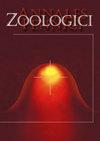Merodon chalybeaus亚群:金黄色分枝杆菌群的另一个谜题
IF 0.9
4区 生物学
Q4 ECOLOGY
引用次数: 2
摘要
在本研究中,我们研究了Merodon chalybeus亚群(金黄色葡萄球菌种群)成员的形态、遗传和分布:M. chalybeus Wiedemann In Meigen, 1822, M. minutus Strobl, 1893, M. robustus veseliki, vujiovic & radenkovovic, 2017。两个物种,M. chalybeus和M. minutus,在形态上非常相似,经常在文献中被错误识别。本文采用综合分类学方法,为M. chalybeus和M. minutus的分离提供了有力的证据。结果表明:M. minutus分布于巴尔干半岛、西西里岛、撒丁岛和科西嘉岛,M. chalybeus为地中海西部种,分布于伊比利亚半岛和非洲西北部。此外,还更新了粗壮菌分布的数据,除其类型产地(希腊的萨摩斯)外,还增加了来自塞浦路斯、以色列和土耳其的新记录。我们提供的证据表明,M. chalybeus和M. minutus代表一个物种复合体,命名为M. chalybeus复合体,与M. robustus一起构成M. chalybeus亚群。本文章由计算机程序翻译,如有差异,请以英文原文为准。
Merodon chalybeus Subgroup: An Additional Piece of the M. aureus Group (Diptera, Syrphidae) Puzzle
In this study, we examined the morphology, genetics and distribution of the members of the Merodon chalybeus subgroup (M. aureus species group): M. chalybeus Wiedemann in Meigen, 1822, M. minutus Strobl, 1893 and M. robustus Veselić, Vujić & Radenković, 2017. Two of the species, M. chalybeus and M. minutus, are morphologically very similar and often misidentified in the literature. Here, by employing an integrative taxonomic approach we provide strong evidence for the separation of M. chalybeus and M. minutus. Our results show their clear allopatric distribution: M. minutus on the Balkan Peninsula, Sicily, Sardinia and Corsica, while M. chalybeus is a western Mediterranean species distributed on the Iberian Peninsula and northwest Africa. Data on the distribution of M. robustus were updated, with new records from Cyprus, Israel and Turkey, besides its type locality (Samos in Greece). We provide evidence for M. chalybeus and M. minutus representing a species complex, named the M. chalybeus complex, which together with M. robustus constitute the M. chalybeus subgroup.
求助全文
通过发布文献求助,成功后即可免费获取论文全文。
去求助
来源期刊

Annales Zoologici Fennici
生物-动物学
CiteScore
2.40
自引率
14.30%
发文量
10
审稿时长
>12 weeks
期刊介绍:
Annales Zoologici Fennici publishes mainly original research reports, but also in-depth reviews and commentaries on all aspects of animal ecology and evolution, and fields related to them. Our aim is to promote papers which focus on the interactions among various components in the past and present environments by using integrative and cross-disciplinary approaches. This may be achieved by employing tools from different fields of research, such as (but not restricted to):
ecology and paleoecology,
molecular ecology and phylogeography,
conservation biology, human-induced contemporary evolution and wildlife management,
animal behaviour and interactions (including recognition systems and mechanisms),
paleontology (except systematics and taxonomy) and evolution,
bioenergetics.
 求助内容:
求助内容: 应助结果提醒方式:
应助结果提醒方式:


